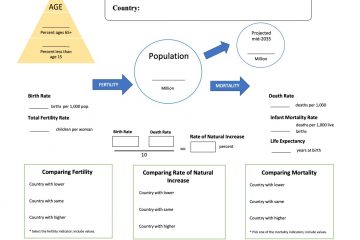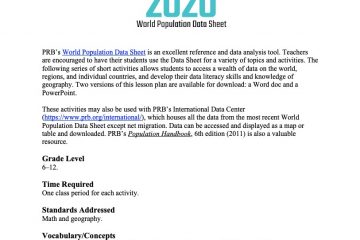Distilled Demographics: What Is Race?
Race is a complex topic in the United States: It’s not scientifically based and its definition depends on the social environment. In this installment of Distilled Demographics, demographer Mark Mather, associate vice president of U.S. Programs at PRB, explains the basics of race and its measurement in the U.S. Census, and how our understanding of race could change over time.
Vignette Démographique: Déchiffrer Les Pyramides Des Ages
(Février 2014) Les pyramides des âge nous donnent un aperçu du profil démographique d’un pays, mais ce qui nous disent-ils sur le passé et le future d’un pays ? Cette vignette démographique montre que les tendances démographique ont des ramifications sociales et économiques.
Distilled Demographics: Population Momentum
When a country’s birth rate reaches roughly two children per woman, then ultimately the population growth stops. “Ultimately” is the key word when it comes to population momentum. In this installment of the educational video series, Distilled Demographics, Carl Haub, senior demographer at PRB, breaks down the dynamics of population momentum, explaining its causes and effects.
Distilled Demographics: Where Do Population Data Come From?
“Distilled Demographics,” PRB’s video series, highlights key demographic concepts such as fertility, mortality, and migration. Through these short videos, you can learn demography’s real-world application and impact. “These videos not only show that demography can be exciting, but also highlight how population trends and issues affects the well-being of us all,” says Carl Haub, senior demographer at PRB. “Fertility, mortality, and migration—along with other demographic issues—play a major role in determining what kind of opportunities and challenges people face in their communities and countries.”
Many people want to know: Where, exactly, do population figures come from? The census is the foundation of demographic statistics, but census-taking is a complicated and difficult process. There are two divisions among the countries of the world in terms of the availability and the quality and completeness of data. Data from developing countries is a little “softer,” and for the most part, incomplete, but countries do try to register births and deaths. These are the numbers that go into many demographic studies, including PRB’s World Population Data Sheet. In this video, PRB senior demographer Carl Haub explains how the demographic data from countries are obtained, highlighting major global surveys and other means.
Distilled Demographics: The Demographic Dividend
The demographic dividend is the accelerated economic growth that may result from a decline in a country’s mortality and fertility and the subsequent change in the age structure of the population. With fewer births each year, a country’s young dependent population grows smaller in relation to the working-age population. With fewer people to support, a country has a window of opportunity for rapid economic growth if the right social and economic policies developed and investments made.
In this episode of Distilled Demographics, Jay Gribble, PRB’s vice president of International Programs, gives an overview of a demographic dividend: what it is and what it takes to achieve it.
PRB’s Distilled Demographics video series is underwritten through the generosity of Juanita Tamayo Lott and Robert H. Lott in support of PRB’s Millennial Generation Outreach Program, and in memory of Jorge del Pinal.
Distilled Demographics: Urbanization
Distilled Demographics,” PRB’s educational video series, highlights key demographic concepts such as fertility, mortality, and migration. Through these short videos, you can learn demography’s real-world application and impact. “These videos not only show that demography can be exciting, but also highlight how population trends and issues affects the well-being of us all,” says Carl Haub, senior demographer at PRB. “Fertility, mortality, and migration—along with other demographic issues—play a major role in determining what kind of opportunities and challenges people face in their communities and countries.”
A few years ago, it was announced that half the world’s population now lives in urban areas. When we think of urbanization, we tend to think of sprawling cities with skyscrapers. However, the definition of “urban” varies greatly from country to country. In this video, PRB senior demographer Carl Haub discusses the global diversity of “urban” areas and the implications of a more urban world.
PRB’s Distilled Demographics video series is underwritten through the generosity of Juanita Tamayo Lott and Robert H. Lott in support of PRB’s Millennial Generation Outreach Program, and in memory of Jorge del Pinal.
Distilled Demographics: How Many People Have Ever Lived on Earth?
Distilled Demographics: Population Projections
“Distilled Demographics,” PRB’s video series, highlights key demographic concepts such as fertility, mortality, and migration. Through these short videos, you can learn demography’s real-world application and impact. “These videos not only show that demography can be exciting, but also highlight how population trends and issues affects the well-being of us all,” says Carl Haub, senior demographer at PRB. “Fertility, mortality, and migration—along with other demographic issues—play a major role in determining what kind of opportunities and challenges people face in their communities and countries.”
Everyone wants to know what the world’s population will be in the future, but how do demographers come up with population projections? It’s important to understand the assumptions behind projections—the factors that are considered such as the current birth rate, contraceptive use, education levels, policy and funding, and more. In this video, PRB senior visiting scholar Carl Haub uncovers how demographers estimate what the population of a country or the world will be in the future.
PRB’s Distilled Demographics video series is underwritten through the generosity of Juanita Tamayo Lott and Robert H. Lott in support of PRB’s Millennial Generation Outreach Program, and in memory of Jorge del Pinal.
Distilled Demographics: Migration
“Distilled Demographics,” PRB’s video series, highlights key demographic concepts such as fertility, mortality, and migration. Through these short videos, you can learn demography’s real-world application and impact. “These videos not only show that demography can be exciting, but also highlight how population trends and issues affects the well-being of us all,” says Carl Haub, senior demographer at PRB. “Fertility, mortality, and migration—along with other demographic issues—play a major role in determining what kind of opportunities and challenges people face in their communities and countries.”
Migration is a minefield for demographers; varying definitions and measurements can be difficult to sort out. Migration is the geographic movement of people across boundaries to establish a new permanent or semipermanent residence. Along with fertility and mortality, migration is a component of population change. The terms “immigration” and “emigration” are used to refer to moves between countries (international migration). The parallel terms “in-migration” and “out-migration” are used for movement between areas within a country (internal migration).
How is an “immigrant” defined? Why do people migrate? How is the world becoming a “melting pot”? In this video, Haub answers these questions and clarifies how migration affects population.
PRB’s Distilled Demographics video series is underwritten through the generosity of Juanita Tamayo Lott and Robert H. Lott in support of PRB’s Millennial Generation Outreach Program, and in memory of Jorge del Pinal.
Distilled Demographics: The Death Rate
“Distilled Demographics,” PRB’s educational video series, highlights key demographic concepts such as fertility, mortality, and migration. Through these short videos, you can learn demography’s real-world application and impact. “These videos not only show that demography can be exciting, but also highlight how population trends and issues affects the well-being of us all,” says Carl Haub, senior demographer at PRB. “Fertility, mortality, and migration—along with other demographic issues—play a major role in determining what kind of opportunities and challenges people face in their communities and countries.”
The 20th century world population “explosion,” from 1.6 billion in 1900 to 6.1 in 2000, was a direct result of the rapid decline in mortality rates in less developed countries. As death rates declined, life expectancy rose, leading to higher population. In this video, Carl Haub uncovers the trends behind this “revolution” in mortality, explains how “crude” death rates are measured, and using examples from various countries, why these measures matter for public health and economic development.
PRB’s Distilled Demographics video series is underwritten through the generosity of Juanita Tamayo Lott and Robert H. Lott in support of PRB’s Millennial Generation Outreach Program, and in memory of Jorge del Pinal.







